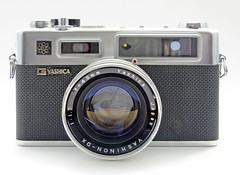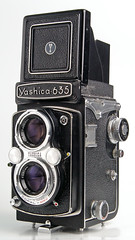Yashica
Contents
Company history
Please cite your sources when editing, and feel free to discuss the contents on the talk page.
Yashica began in December, 1949 in Nagano, Japan, when the Yashima Seiki Company (八洲精機株式会社) was founded with an initial investment of $566. Its eight employees originally manufactured components for electric clocks. Later, it began making camera components, and by June 1953 had changed its name to Yashima Optical Industry Company, Ltd. (八洲光学精機株式会社, Yashima Kōgaku Seiki K.K.), manufactured its first complete cameras, the Pigeonflex, and manufactured and marketed its first, the Yashimaflex.[1] The Pigeonflex and Yashimaflex are twin-lens reflex (TLR) cameras designed for 6×6cm exposures on 120 rollfilm; they and successive cameras used lenses sourced from the Tomioka Optical Works, beginning a relationship that would last for years.
Yashima continued to refine and improve its TLR cameras, and a improved series named 'Yashicaflex' was introduced in 1954 with semi-automatic winding. In 1957, Yashima founded Yashica, Inc., a subsidiary arm in New York City to manage marketing efforts in the USA. 1957 also marked the introduction of a popular new TLR camera series, the Yashica Mat line. During the next year and a half, Yashima continued to grow, with 1,982 employees by 1958. Later in 1958, Yashima changed its name to Yashica Company, Ltd, when it acquired the Nicca Camera Company, Ltd. The Nicca acquisition was fortuitous, greatly expanding the company’s market into 35mm film cameras.
The Yashica Pentamatic, an advanced, modern 35mm Single Lens Reflex (SLR) camera with a proprietary bayonet-mount and interchangeable lenses, was introduced in 1959. Bowing to consumer preferences of the day, Yashica later reversed course and adopted the popular M42 screw-mount for the Penta J and later 35mm SLR models. As before, Yashica continued to source its lenses from the Tomioka Optical factory. Around 1960-61, Yashica made yet another important acquisition, the Zunow Optical Industry Co. Ltd. Though a small company, Zunow had become well-known for its limited production of a very advanced SLR camera, along with several high-quality, fast lens designs.
In December 1965, Yashica introduced the world’s first electronically controlled 35mm camera, the Electro-35, a popular rangefinder model that eventually sold 5 million units. The company continued to expand its international markets, and in August 1968, Yashica finally acquired its lens manufacturer, the Tomioka Optical and Machine Manufacturing Co., Ltd. (later re-named the Tomioka Optical Co. Ltd.). By this time, Tomioka was one of the largest and most reputable lens manufacturers in Japan. Sales of 35mm SLRs continued to grow steadily, and Yashica was quickly acquiring a reputation for both electronic camera expertise and high-quality optics. 1968 also marked the year of Yashica's last major TLR camera design, the Yashica Mat-124, a popular model which combined some of the best features of Yashica's earlier TLR cameras.
By 1973, Yashica was a production giant with considerable electronic camera experience, and was seeking ways to expand sales and improve brand name recognition in the highly competitive 35mm SLR market. Thus began ‘Top Secret Project 130’, a collaboration with Carl Zeiss to produce a new, professional 35mm SLR with an electronically-controlled shutter, bearing the Contax brand name. A new prestige line of Yashica / Contax lenses designed by Carl Zeiss were introduced for the camera, with a common C/Y bayonet mount allowing lens interchange between all 35mm Contax and Yashica SLR models - an innovation that was to prove very popular with camera buyers. Yashica also took the opportunity to upgrade and expand its line of 35mm SLR lenses (DSB, ML) with the new mount, as well as introducing improved optical designs and coating technologies. The F. Alexander Porsche Group was hired to complete an ergonomic and styling study of the new camera. The new Contax RTS appeared at Photokina in 1974, and proved an immediate hit.
Within the Yashica line, the new C/Y bayonet mount first appeared with the FX-1 (1975) and FX-2 (1976). Also in that year, Yashica developed the upscale Yashica FR. The FR, based in part on the Contax RTS design, was a manual-exposure, electronically-controlled camera designed to appeal to the semi-professional and serious amateur user, while also capable of using the entire range of Carl Zeiss T* lenses. This practice of ‘pairing’ similar Contax models with more affordable, less full-featured, but still high-quality Yashica models would continue for the next 10 years.
The FR was quickly followed in April 1977 by the FR-I and FR-II. The FR-I had both manual and auto-exposure modes, and was even closer in design and features to the premium Contax RTS. The FR-II was an auto-exposure only SLR designed for a growing market of new photographers who did not want or need full manual metering capability. The FR-I and FR-II reached the U.S. market early in 1978. All of these cameras were on the whole extremely well-designed and manufactured, and even incorporated a few improvements over the RTS. Popular Photography tested the FR in its September, 1977 issue and described the camera as being tougher in some ways and better sealed against dust than its older brother. Along with the ability to mount Carl Zeiss T* lenses, Yashica offered a multitude of Contax/Yashica accessories and power winders for the FR series, competing seriously for the first time in the professional and semi-pro SLR marketplace.
In 1979, Yashica introduced a new inexpensive 35mm consumer SLR, the FX-3, intended for entry-level buyers. Like all Yashica manual-focus bodies, the affordable FX-3 would also accept Carl Zeiss T* lenses. This simple, lightweight manual-exposure SLR camera proved to be an immediate hit with new and experienced photographers alike, and millions were eventually sold. The FX-3 was developed by Yashica and produced by Cosina, a company with a successful history of making cameras for many other camera brands, including Minolta, Olympus, Revue, and Vivitar. In the early 1980s, the compact, mid-priced FX-D and FX-70 cameras were introduced to good reviews. As before, these cameras were derivatives of the current Contax models (139Q and 137MA). The new Yashicas signalled the company's return to its middle-of-the road, moderately priced amateur market.
In October 1983, Yashica Company Ltd. was acquired by ceramics giant Kyocera. Initially, the merger resulted in few outward changes. The manual-focus (MF) FX-103 Program, introduced in 1985, continued the ‘pairing’ tradition of high-end Yashica SLR models with Contax (Contax 159mm), and was the first Yashica SLR with TTL flash and full programmed exposure capabilities.
After 1983, Yashica cameras were made by Kyocera (Kyoto Ceramics), which also made newer Contax cameras.
In 2005, Kyocera halted production on all Contax, Yashica, and other Kyocera branded film and digital cameras.
35mm film
SLR
Yashica proprietary bayonet mount
- Yashica Pentamatic
- Yashica Pentamatic II
- Yashica Pentamatic S
M42 screw thread mount
- Yashica Penta J
- Yashica J-3 [1]
- Yashica J-4
- Yashica J-5
- Yashica J-7
- Yashica TL
- Yashica TL-E
- Yashica TL Electro
- Yashica TL Electro-AX
- Yashica TL Electro-X
- Yashica TL Electro-X ITS
- Yashica TL Super
Contax / Yashica (C/Y) bayonet mount
- FR
- FR I
- FR II
- FX-1
- FX-2
- FX-3
- FX-3 Super / FX-7 Super
- FX-3 Super 2000
- FX-D Quartz
- FX-70 Quartz
- FX-103 Program
- 107 MP
- 108 MP
- 109 MP
Autofocus SLR (Kyocera/Yashica mount)
- 200 AF
- 230 AF
- 270 AF
- 300 AF
Autofocus SLR (fixed lenses)
Rangefinder, fixed lens
- Yashica 35YJ
- Yashica Electro 35 FC
- Yashica Electro 35 GSN
- Yashica Electro 35 GTN
- Yashica Electro 35 series
- Yashica Electro CC
- Yashica Electro G
- Yashica Electro GS
- Yashica Electro GT
- Yashica Electro GX
- Yashica Electro-X
- Yashica J
- Yashica Lynx 1000
- Yashica Lynx 14 & 14E
- Yashica Lynx 5000 & 5000E
- Yashica MG-1
- Yashica Minister
- Yashica Minister D
- Yashica Minister II
- Yashica Minister III
Rangefinder, interchangeable lens
- Yashica YE
- Yashica YF
- Yashica YK
Viewfinder
120 film
6×6 TLR
- Pigeonflex (original model)
- Yashimaflex
- Yashicaflex A, B, C, S, AS
- Yashica Rookie
- Yashica-A
- Yashica-B
- Yashica-C
- Yashica-D
- Yashica-E
- Yashica-635
- Yashica-Mat
- Yashica-Auto
- Yashica-Mat LM
- Yashica-Mat EM
- Yashica-12
- Yashica-24
- Yashica Mat-124
- Yashica Mat-124G
127 film
4×4 TLR
4×4 rigid
126 film
- Yashica EZ-matic
- Yashica EZ-Matic Electronic
- Yashica EZ-Matic 4
- Yashica Minipak
16mm film
Minox film
APS film
Notes
- ↑ On the Pigeonflex as Yashima's first camera: Kyōshū no burando ten, p.10.
Source / further reading
- Nihon no kamera o omoshiroku shita kyōshū no burando ten (日本のカメラを面白くした郷愁のブランド展, Exhibition of nostalgic brands that made Japanese cameras interesting). Tokyo: JCII Camera Museum, 1997. Exhibition catalogue; pp.11 profile seven Yashima/Yashica cameras.
Links
- Yashica SLR Pages
- The Yashica Guy
- The Yashica Old SLR Site
- Yashica Forum
- The unofficial Contax & Yashica User Forums - English and German
- User manuals for many Yashica SLR cameras and Yashica MAT 35mm and 2¼ cameras. Manuals in PDF (Adobe 5.0 and above required) and HTML format that can be translated. A few Yashica Mat exploded views available.
- Yashica TLRs
- Yashica page at Collection G. Even's site
- Yashica Cameras Price Guide at CollectiBlend
In French :
- Cameras and user manuals at www.collection-appareils.fr
- Yashica camera's in Andrys Stienstra's camera collection


